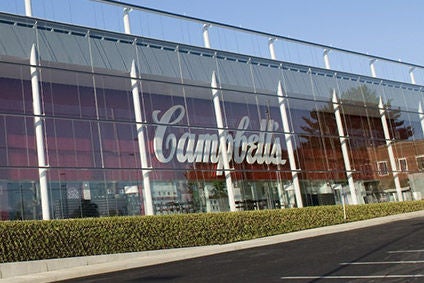
Campbell Soup Co. is seeing some market-share erosion from private label in select categories as consumers trade down due to the cost-of-living crunch.
The US-based soups, sauces and snacks maker has raised prices in two waves, with a third round anticipated before Campbell enters its new financial year in August. Volumes declined 3% in the third quarter to 1 May “driven by select supply constraints and price elasticities”, the company said.
President and CEO Mark Clouse explained on a follow-up analyst call that Italian sauces and some soups were relatively insulated from own-label encroachment, while snacks were propped up as private-label lost share. But Campbell’s condensed soup lines and its Swanson brand of broths and stocks did see some “share pressure” from discount lines.
“We continued to see strong share performance on key brands but as expected we did see pockets of share pressure, in particular on condensed soup and Swanson, where inflation and slower private-label pricing put some pressure on share,” Clouse explained.
However, supply constraints as pandemic-related disruptions continue also had a bearing.
“These share losses tend to line up very closely with where our distribution levels were down, evidence that supply was one of the key drivers of this pressure,” he said. “Despite recent average prices on shelf increasing in our key categories of soup and Italian sauce in the low- to mid-double digits, volumes are still elevated versus the prior year, indicating that both the soup and Italian sauce categories are staying in consumers’ baskets as prices are rising.”
In snacks, Campbell’s sales were supported by Goldfish crackers, and, in the salty segment by Snyder’s of Hanover pretzels and Kettle potato chips.
“We have seen very little elasticity or trade down due to price sensitivity so far,” Clouse noted. “This is true more broadly across all of salty snacks.”
Publicly-listed Campbell is pricing for low-double-digit inflation for the full fiscal year, with a “more pronounced impact” in the second half. Two rounds of pricing helped drive 9% organic growth in the third quarter, while Campbell pointed to improvements in long-term labour shortages supporting service levels.
However, there was still an impact on volumes from staffing “driven by select labour and materials constraints and some price elasticities, albeit much lower than historical levels”, Clouse said.
He added: “We anticipate and have plans for similar volume trends going forward where demand and inventory replenishment is mitigated by some ongoing materials availability and price elasticity. We are remaining vigilant on elasticities with a variety of contingency plans in place if they begin to accelerate.”
Nevertheless, the CEO was pressed during the Q&A discussions on whether consumers can stomach further price increases.
“I just think we’ve got to be very prudent about it. And I think that’s similar sentiment that we’re hearing with our retail partners,” he countered. “Where we may be seeing elasticities begin to creep up, we obviously have to be a lot more careful there.”
Campbell’s third-quarter gross margin fell 90 basis points to 31.2% but on an adjusted basis was up by the same magnitude. Volume and mix had a negative 50-point-impact, while inflation weighed on the margin to the tune of 790 points due to higher input costs.
Input prices increased by about 15% in the quarter, CFO Mick Beekhuizen said.
“Net price realisation drove an 800 basis-point improvement due to the impact of our inflation-driven pricing actions, which only partially offset the inflationary headwinds experienced in the quarter,” Beekhuizen added.
Campbell retained its full-year guidance for adjusted EBIT and earnings per share to “reflect the ongoing inflation pressure”. But despite a flat sales performance over the nine months of fiscal 2022, the company raised its outlook.
Third-quarter sales were up 7% on a reported basis (9% organic growth) at US$2.13bn. Year-to-date sales were $6.58bn, an organic increase of 1%.
For the year, Campbell now anticipates organic growth of 1-2%, compared to a previous estimate of minus 1% to plus 1%.
EBIT climbed 8% in the quarter to $294m, and rose 23% on an adjusted basis to $321m. The nine-month prints were $993m and $1.03bn, down 12% and 7%, respectively.
Guidance for adjusted EBIT remains at a negative 1.5% to minus 4.5%.
Adjusted EPS was up in quarter three at $0.70 versus $0.51 a year earlier, but fell for the year so far to $2.28 from $2.33. Minus 4% to flat is expected over the 12 months at $2.75-$2.83.
Meanwhile, Campbell’s net earnings rose 17.5% in the quarter to $188m but fell 7.4% year-to-date to $661m.
Clouse concluded: “While we feel very good about the progress we’ve made, the operating environment remains challenging, and we expect ongoing margin pressure from inflation”.
Campbell will use other tools in its box to deal with inflation and margin pressure, he said, along with “leverage improving supply and execution to further recover distribution”, and “return promotional and marketing investment to strengthen competitiveness and combat private-label trade down”.



